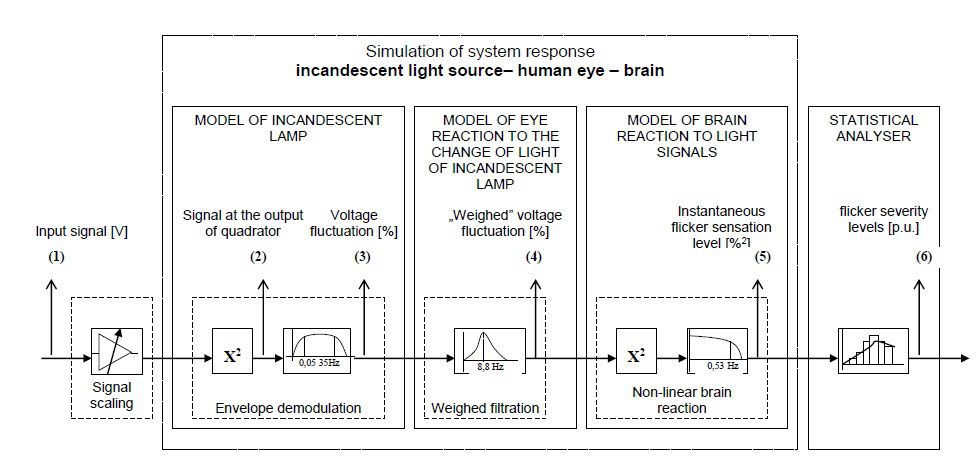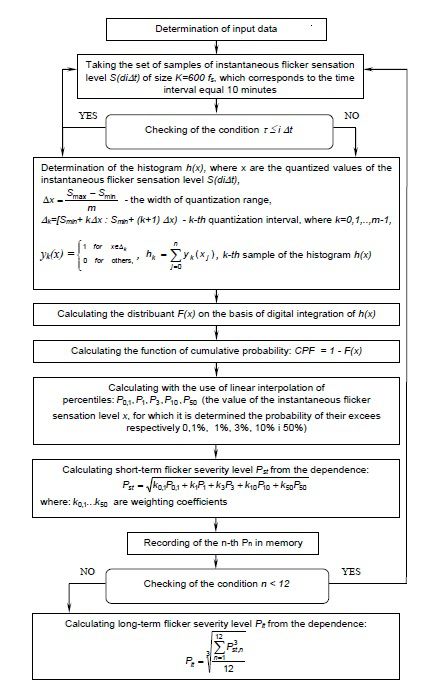A cumulative probability function of instantaneous flicker sensation values measured in the industrial power system supplying the rolling mill motors

Opis
The dataset presents a cumulative probability function CPF of the instantaneous flicker sensation level measured on the bus bars of the main switchgear of the industrial power network for the supply of rolling mills. The data were obtained during an experiment whose purpose was to determine a level of short-term and long-term flicker caused by voltage fluctuations. In the virtual application of flickermeter, a hardware (acquisition of measuring data) and a software (computer data processing and graphical interface) part is distinguished. The attached dataset contains analysis results based on processed data at the output of the software part of the flickermeter.
The principle of determination of flicker severity has been given in IEC Technical Report. Luminous flux variations (flicker) of incandescent light sources have been assumed as voltage variation indicator (Fig. 1). By referring the output signal (output 5 in Fig. 1) to a value corresponding to the flicker perceptibility threshold, we will obtain a relative value, which when greater than 1 [p.u.] means that the flickering intensity has exceeded the irritability threshold and can be irritating for the observer. Because of a random character of the flicker phenomenon, two statistical factors Pst and Plt are to be determined. Short-term flicker severity level Pst is determined by means of a cumulative probability function CPF of instantaneous flicker sensation values. This is a curve of orderly probabilities, which does not exceed definite values of the flicker levels in the respective time, for a recording period of the course under investigation equal to 10 minutes.
The virtual application of the flicker severity meter Flickermeter. vi is developed in the LabVIEW programming environment. The following input data are introduced at the input of the virtual instrument, consisting of two sub-programs: one determining the instantaneous flicker sensation level and a statistical analyzer (Fig. 2), in which the flicker severity factors are calculated:
- fs sampling frequency equal to 20 000 S/s,
- Ts time of observation equal to 10 min,
- procedure repeating time,
- m number of quantization levels (classes).
A cumulative probability function CPF is calculated for a time window with a width of 10 minutes, moving on the time scale with a step of 1 minute.
The presented statistical analyzes concern data from the inst_flicker_1.txt file [Pałczyńska, B. (2021). The instantaneous flicker sensation level measured in the industrial power system supplying the rolling mill motors [Data set]. Gdańsk University of Technology. https://doi.org/10.34808/c84g-4x89].
CPFs are calculated over a total measurement time of 60 minutes, for 10-minute time windows, shifting in 1-minute steps. The files are described as follows: cpf(time window) next minute in the time window. For example, the file marked as follows cpf(21-30)3 relates to measurements in the 21-30 min time window, which starts from 2 minutes of that window.

Figure 1. The method of determining the flicker severity levels

Figure 2. Algorithm of calculating the flicker severity levels Pst and Plt
Plik z danymi badawczymi
hexmd5(md5(part1)+md5(part2)+...)-{parts_count} gdzie pojedyncza część pliku jest wielkości 512 MBPrzykładowy skrypt do wyliczenia:
https://github.com/antespi/s3md5
Informacje szczegółowe o pliku
- Licencja:
-
otwiera się w nowej karcie
CC BYUznanie autorstwa
Informacje szczegółowe
- Rok publikacji:
- 2021
- Data zatwierdzenia:
- 2021-06-25
- Data wytworzenia:
- 2000
- Język danych badawczych:
- angielski
- Dyscypliny:
-
- Automatyka, elektronika i elektrotechnika (Dziedzina nauk inżynieryjno-technicznych)
- DOI:
- Identyfikator DOI 10.34808/vkv8-9768 otwiera się w nowej karcie
- Seria:
- Weryfikacja:
- Politechnika Gdańska
Słowa kluczowe
- voltage fluctuations
- flickermeter
- switchgear of the industrial power network
- rolling mill
- instantaneous flicker sensation level
- flicker
- cumulative probability function
Powiązane zasoby
- dane badawcze Voltage fluctuations on the main switchgear of the industrial power system supplying the rolling mill motors
- dane badawcze Voltage fluctuations on the main switchgear of the industrial power system supplying the rolling mill motors_part_2
- dane badawcze The instantaneous flicker sensation level measured in the industrial power system supplying the rolling mill motors
- dane badawcze The short-term flicker severity level measured in the industrial power system supplying the rolling mill motors
Cytuj jako
Autorzy
wyświetlono 241 razy
